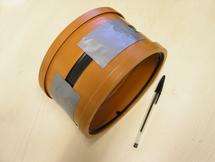One of the tags developed by OxEmS
(PhysOrg.com) -- A new Oxford University spin-out company, Oxford Electromagnetic Solutions Limited (OxEmS), has been set up to commercialise technology to locate and identify buried plastic pipes.
OxEmS was spun out by Isis Innovation, Oxford University's technology transfer company, to produce solutions for the utilities sector.
As the utility infrastructure ages, metal pipes, such as cast iron gas mains, are rapidly being replaced with plastic ones. However, buried plastic pipes are notoriously difficult to detect using current methods which are expensive, inefficient and in many cases don't produce the quick and accurate results required.
The new tag and sensor technology OxEmS is deploying was developed at the Department of Engineering Science and uses an extension of radio frequency identification and detection (RFID) and passive low frequency tags to give each buried plastic pipe a unique frequency domain ID, rather like a 'barcode'. The pipe's location and this code which provides immediate information on the type of service carried as well as providing access to remote data related to the asset, can be detected from the surface using a new locator which OxEmS is developing.
It is estimated that there are over 4 million kilometres of buried pipes and cables in the UK, with around 100,000km of cast iron gas main considered at high risk of failure and in need of replacement. It is intended that the new technology will address all kinds of buried infrastructure, including water, gas, power, and telecommunications, and could reduce the costs to utilities of street works by at least 40%.
The new system is designed to be low cost to install, robust and requiring very low maintenance. Crucially it also performs well in wet conditions enabling the location essential for pinpointing failed pipes responsible for water leaks.
Professor David Edwards of the Department of Engineering Science led the founding team comprising Dr Harvey Burd, Dr Christopher Stevens and Dr Tong Hao that developed the technology at Oxford University.
Professor David Edwards said: ‘We originally started working on the problems industry faced in this area as part of the ‘Mapping the Underworld’ call from the Engineering and Physical Sciences Research Council (EPSRC), which led to the domain ‘barcode’ approach. Our previous work in underwater pipe detection enabled us to model the response from wet environments and develop the OxEmS technology based on a long history of working on long range detection and positioning systems.’
Kevin Gooding, CEO of OxEmS, said: ‘One of the major benefits to utility firms of the OxEmS solution is that the ‘intelligent’ part of the technology is on the surface, so that the buried tagging units are simple, leading to significantly reduced unit costs as well as increased reliability and longevity. It also means less street work disruption for the rest of us, with no more ‘dry holes’ where a contractor digs a hole but finds nothing.’
Provided by Oxford University






















